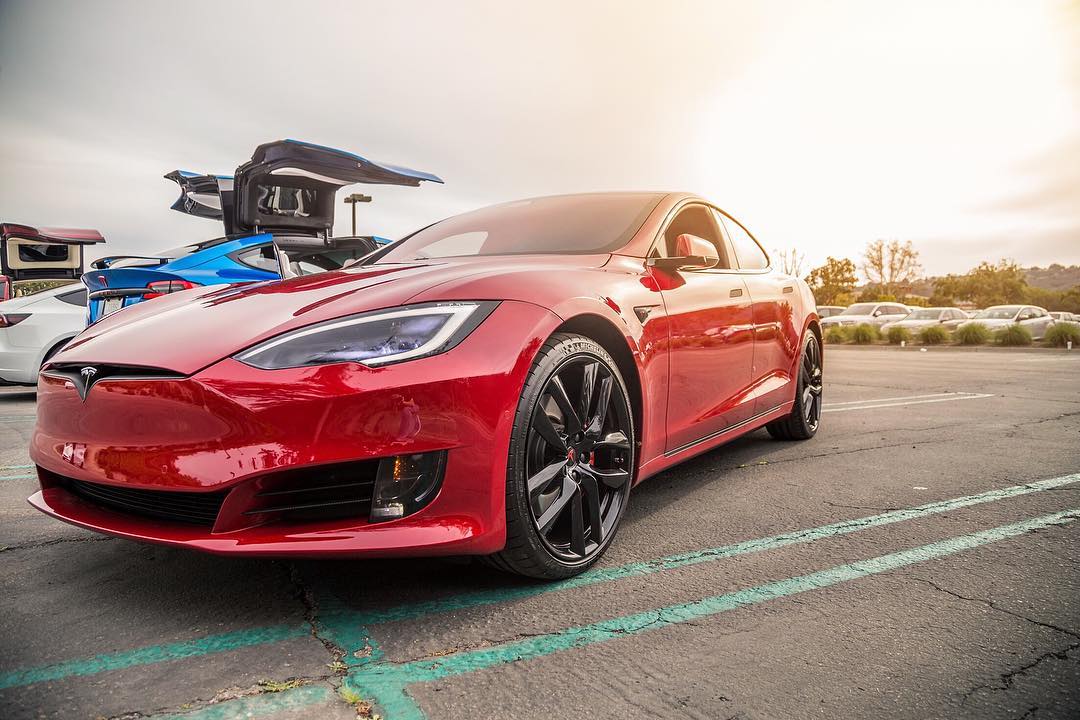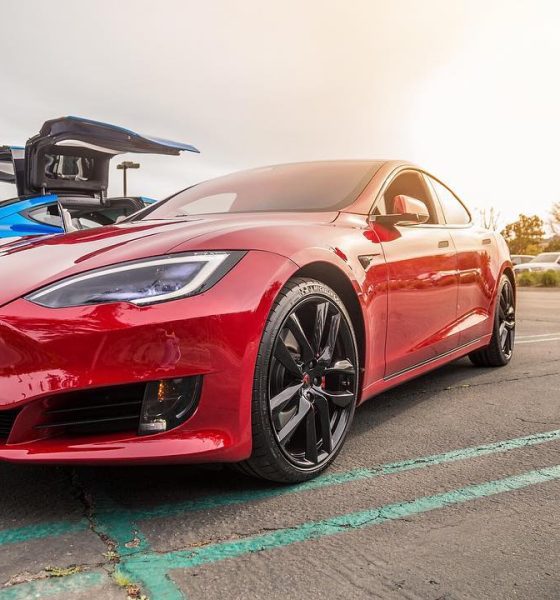

News
Tesla to shut down Model S and Model X lines for rumored design “refresh”
Recently leaked emails from Tesla CEO Elon Musk have revealed that the electric car maker intends to shut down the Model S and Model X line at the Fremont Factory for 18 days starting December 24, 2020. The reasons behind the halt in the flagship sedan and SUV’s production were not specified by the company, though speculations suggest that the 18-day halt may be used to introduce some much-needed hardware updates for the Model S and Model X.
In one of his emails, a copy of which was retrieved by CNBC, Elon Musk announced that Tesla employees working on the Model S and X line will be offered a full week of pay to cover 7 of the 18 days that will be affected by the shutdown. The CEO also encouraged the affected workers to volunteer and help out in the company’s Q4 delivery efforts.
Following is Elon Musk’s email in full:
Subject: S/X Holiday Shutdown
Hi Team,
The SX lines will be shut down for the holidays starting Dec. 24th and returning Jan. 11th.
We would like you to take the opportunity to refresh or spend time with your family, so Tesla will be giving you a full week pay for the week of Jan. 4th. There will also be limited paid opportunities for you to support other shops or volunteer for deliveries during some of this time.
Dec. 23rd – last day of work before shutdown
Dec. 24th-25th – Paid holidays*
Dec. 28th-30th – Unpaid time off (may use PTO**), support deliveries or other shops.
Dec. 31st-Jan. 1st – Paid Holiday*
Jan. 4th – 8th – Paid time off (40 hours)
Jan. 11th – return to work
If you would like to volunteer for deliveries for Dec. 26th — Dec. 31st, or support other shops from Dec. 28th – Dec. 30th, please use the survey below to let us know your preference. We will do our best to accommodate your requests, but preferences are not guaranteed and will be granted on a first come first serve basis.
While the shutdown of the Model S and Model X line this Q4 may be interpreted as a bearish sign of declining demand by Tesla critics, the production halt does give the company some time to update the vehicles’ manufacturing facilities. Tesla has kept silent about any upcoming improvements for the Model S and Model X, of course, but considering the company’s reputation and nature, it would not be surprising if it ends up using the 18-day shutdown to make sure that the two flagship vehicles will return better than ever.
In a separate email, Elon Musk emphasized that Tesla’s main issue today is demand. In true Tesla fashion, Musk also asked for any suggestions that would help the company improve its output further. Such improvements would go a long way in aiding Tesla this fourth quarter, seeing as the company would have to deliver about 180,000 vehicles before the end of the year to meet its half-a-million vehicle target for 2020.
Following is Musk’s email to Tesla employees about the matter.
Subject: Vehicle Production
We are fortunate to have the high class problem of demand being quite a bit higher than production this quarter.
To ensure that we have the best possible customer outcome and earn the trust of the customers and investors who have placed their faith and hard-earned money with us, we need to increase production for the remainder of the quarter as much as possible.
I would only send this note if it really mattered.
Super appreciated,
Elon
Btw, please send me a note directly if you see ways to improve output, but feel that your voice is not being heard.

News
Tesla FSD v14.2.2 is getting rave reviews from drivers
So far, early testers have reported buttery-smooth drives with confident performance, even at night or on twisty roads.

Tesla Full Self-Driving (Supervised) v14.2.2 is receiving positive reviews from owners, with several drivers praising the build’s lack of hesitation during lane changes and its smoother decision-making, among others.
The update, which started rolling out on Monday, also adds features like dynamic arrival pin adjustment. So far, early testers have reported buttery-smooth drives with confident performance, even at night or on twisty roads.
Owners highlight major improvements
Longtime Tesla owner and FSD user @BLKMDL3 shared a detailed 10-hour impression of FSD v14.2.2, noting that the system exhibited “zero lane change hesitation” and “extremely refined” lane choices. He praised Mad Max mode’s performance, stellar parking in locations including ticket dispensers, and impressive canyon runs even in dark conditions.
Fellow FSD user Dan Burkland reported an hour of FSD v14.2.2’s nighttime driving with “zero hesitations” and “buttery smooth” confidence reminiscent of Robotaxi rides in areas such as Austin, Texas. Veteran FSD user Whole Mars Catalog also demonstrated voice navigation via Grok, while Tesla owner Devin Olsen completed a nearly two-hour drive with FSD v14.2.2 in heavy traffic and rain with strong performance.
Closer to unsupervised
FSD has been receiving rave reviews, even from Tesla’s competitors. Xpeng CEO He Xiaopeng, for one, offered fresh praise for FSD v14.2 after visiting Silicon Valley. Following extended test drives of Tesla vehicles running the latest FSD software, He stated that the system has made major strides, reinforcing his view that Tesla’s approach to autonomy is indeed the proper path towards autonomy.
According to He, Tesla’s FSD has evolved from a smooth Level 2 advanced driver assistance system into what he described as a “near-Level 4” experience in terms of capabilities. While acknowledging that areas of improvement are still present, the Xpeng CEO stated that FSD’s current iteration significantly surpasses last year’s capabilities. He also reiterated his belief that Tesla’s strategy of using the same autonomous software and hardware architecture across private vehicles and robotaxis is the right long-term approach, as it would allow users to bypass intermediate autonomy stages and move closer to Level 4 functionality.
News
Elon Musk’s Grok AI to be used in U.S. War Department’s bespoke AI platform
The partnership aims to provide advanced capabilities to 3 million military and civilian personnel.

The U.S. Department of War announced Monday an agreement with Elon Musk’s xAI to embed the company’s frontier artificial intelligence systems, powered by the Grok family of models, into the department’s bespoke AI platform GenAI.mil.
The partnership aims to provide advanced capabilities to 3 million military and civilian personnel, with initial deployment targeted for early 2026 at Impact Level 5 (IL5) for secure handling of Controlled Unclassified Information.
xAI Integration
As noted by the War Department’s press release, GenAI.mil, its bespoke AI platform, will gain xAI for the Government’s suite of tools, which enable real-time global insights from the X platform for “decisive information advantage.” The rollout builds on xAI’s July launch of products for U.S. government customers, including federal, state, local, and national security use cases.
“Targeted for initial deployment in early 2026, this integration will allow all military and civilian personnel to use xAI’s capabilities at Impact Level 5 (IL5), enabling the secure handling of Controlled Unclassified Information (CUI) in daily workflows. Users will also gain access to real‑time global insights from the X platform, providing War Department personnel with a decisive information advantage,” the Department of War wrote in a press release.
Strategic advantages
The deal marks another step in the Department of War’s efforts to use cutting-edge AI in its operations. xAI, for its part, highlighted that its tools can support administrative tasks at the federal, state and local levels, as well as “critical mission use cases” at the front line of military operations.
“The War Department will continue scaling an AI ecosystem built for speed, security, and decision superiority. Newly IL5-certified capabilities will empower every aspect of the Department’s workforce, turning AI into a daily operational asset. This announcement marks another milestone in America’s AI revolution, and the War Department is driving that momentum forward,” the War Department noted.
News
Tesla FSD (Supervised) v14.2.2 starts rolling out
The update focuses on smoother real-world performance, better obstacle awareness, and precise end-of-trip routing, among other improvements.

Tesla has started rolling out Full Self-Driving (Supervised) v14.2.2, bringing further refinements to its most advanced driver-assist system. The new FSD update focuses on smoother real-world performance, better obstacle awareness, and precise end-of-trip routing, among other improvements.
Key FSD v14.2.2 improvements
As noted by Not a Tesla App, FSD v14.2.2 upgrades the vision encoder neural network with higher resolution features, enhancing detection of emergency vehicles, road obstacles, and human gestures. New Arrival Options let users select preferred drop-off styles, such as Parking Lot, Street, Driveway, Parking Garage, or Curbside, with the navigation pin automatically adjusting to the user’s ideal spot for precision.
Other additions include pulling over for emergency vehicles, real-time vision-based detours for blocked roads, improved gate and debris handling, and extreme Speed Profiles for customized driving styles. Reliability gains cover fault recovery, residue alerts on the windshield, and automatic narrow-field camera washing for new 2026 Model Y units.
FSD v14.2.2 also boosts unprotected turns, lane changes, cut-ins, and school bus scenarios, among other things. Tesla also noted that users’ FSD statistics will be saved under Controls > Autopilot, which should help drivers easily view how much they are using FSD in their daily drives.
Key FSD v14.2.2 release notes
Full Self-Driving (Supervised) v14.2.2 includes:
- Upgraded the neural network vision encoder, leveraging higher resolution features to further improve scenarios like handling emergency vehicles, obstacles on the road, and human gestures.
- Added Arrival Options for you to select where FSD should park: in a Parking Lot, on the Street, in a Driveway, in a Parking Garage, or at the Curbside.
- Added handling to pull over or yield for emergency vehicles (e.g. police cars, fire trucks, ambulances).
- Added navigation and routing into the vision-based neural network for real-time handling of blocked roads and detours.
- Added additional Speed Profile to further customize driving style preference.
- Improved handling for static and dynamic gates.
- Improved offsetting for road debris (e.g. tires, tree branches, boxes).
- Improve handling of several scenarios, including unprotected turns, lane changes, vehicle cut-ins, and school buses.
- Improved FSD’s ability to manage system faults and recover smoothly from degraded operation for enhanced reliability.
- Added alerting for residue build-up on interior windshield that may impact front camera visibility. If affected, visit Service for cleaning!
- Added automatic narrow field washing to provide rapid and efficient front camera self-cleaning, and optimize aerodynamics wash at higher vehicle speed.
- Camera visibility can lead to increased attention monitoring sensitivity.
Upcoming Improvements:
- Overall smoothness and sentience.
- Parking spot selection and parking quality.








